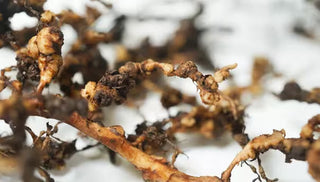Various species of these microscopic worms are found all over North America, but they are a more severe problem in the South. They feed on the roots of a wide variety of plants, including tomatoes, celery, beans, and spinach. Infected plants are stunted, yellow, may wilt during hot, dry weather, or die if severely infected. Roots may have many small, round nodules on them, and taproots, such as carrots, may develop many small side roots. Nematodes are spread via infected soil, water, tools, and plants. Damage is similar to that caused by other stresses that injure roots; have your soil tested for nematodes to verify that they are the culprit.
 Closeup of a sugar beet with severe galling from root-knot nematodes. Photo: Mactode Publications, Bugwood.org
Closeup of a sugar beet with severe galling from root-knot nematodes. Photo: Mactode Publications, Bugwood.org
Prevention and Control
Plant resistant varieties. Keep the soil's organic matter level high to encourage nematode antagonists. Tilling in a rye cover crop produces a substance toxic to nematodes. Leaving fields fallow and weed-free for 1 to 2 years usually have an 80 to 90 percent per year reduction in root-knot populations.
In warmer areas, soil solarization (using the sun's heat to kill the seeds). Till soil, water thoroughly, and cover soil with sheets of clear 2- or 4-mil plastic. (A double layer, separated by a garden hose for instance, increases effectiveness.) Seal the edges with soil or stones. Sunlight passes through the plastic and heats the soil, which stays warm. The goal is to raise soil temperatures 3-6" deep above 100 degrees F. Depending upon the amount of sun and how hot it is, the process can take six to eight weeks.
 Pepper plant roots with extensive galling (thickened, lumpy portions) are heavily infested by the Southern root-knot nematode. Photo: Scott Bauer/USDA Agricultural Research Service.
Pepper plant roots with extensive galling (thickened, lumpy portions) are heavily infested by the Southern root-knot nematode. Photo: Scott Bauer/USDA Agricultural Research Service.




